May 2017 – A priceless jewel of antiquity lies just west and north of Santa Fe, New Mexico, not far from Kasha-Katuwe Tent Rocks National Monument. It is the classic ancient pueblo ruins at Bandelier National Monument.

Bandelier National Monument is a “hands-on” (actually “feet-on”) kind of place!
We’ve visited lots of cliff dwellings and pueblo ruins over the years at Tonto, Wupatki and Montezuma’s Castle in Arizona and Aztec Ruins in New Mexico, but the glimpses of the past and the evidence of the ancients’ ingenuity at Bandelier National Monument makes this place my personal favorite so far.
One of the most wonderful aspects of Bandelier National Monument is that the National Park Service has installed lots of replicas of pueblo ladders for visitors to use so they can get a closer look inside!

We loved climbing up and down the ladders
to peek into the cliff dwellings.
The Ancestral Puebloan people lived here between 1150 and 1550 AD. They lived not only in the caves in the cliff walls but also in adobe brick dwellings. A large group of buildings very similar to those at Aztec Ruins National Monument fills a field and is called Tyuonyi Village. Other masonry buildings were built as extensions off the cliff dwellings in the cliff walls.

The Ancestral Puebloans took advantage of the huge bubbles in the volcanic rock,
building out from there with adobe brick.
Adolph Bandelier first saw the ruins in 1880. Then, in the early 1930’s, CCC workers created a huge camp to house themselves as they set about stabilizing and reconstructing the ruins. A reconstructed “Talus House” has been rebuilt and was easy to see as we passed it on the Main Loop Trail.

This reconstructed building is what all the buildings looked like at one time.
Bandelier National Monument is so popular that visitors arriving during the prime daytime hours between mid-May and mid-October must take a free shuttle bus into the park. The free Atomic City Transit bus picks people up in nearby Los Alamos, home of the secret Manhattan Project that developed the atomic bomb in the 1940’s.
We wanted to see the ruins without the bus crowds, however, so we were at the gate with our truck when they first opened, before they close the parking lot to private cars. We ran out on the trail and discovered to our delight that we were the only people there.

.
Being at the ruins in the quiet morning air was fabulous. We scampered up and down the ladders in sheer delight.

Going for a peek inside!
The astonishing highlight of the Main Loop trail is the very long Long House. This is a huge expanse of sheer rock cliff that has dozens of indents and holes in it where the Ancestral Puebloan people anchored their homes.

The Long House is a series of apartments that were built to butt up against the sheer cliff walls with adobe brick construction extending out from there.
The cliffs are part of the Jemez Volcanic field, and the bubbly nature of the cooling lava is readily apparent with thousands of one- or two-person sized holes and crevices lining the stone.

Each indent is the end of a room. Holes bored in the rock supported tree trunk beams
that were floor joists and roof trusses.
The ancients used these holes — and carved others — as rooms or as ends of rooms. They also bored holes in the cliffs to support the ends of wooden beams. These beams supported ceilings and floors and second and third story rooms.
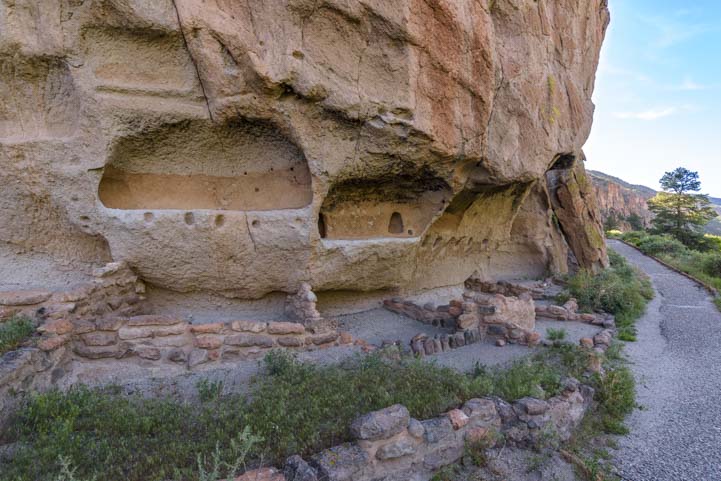
.
What amazed me as I looked a little closer at these ruins along the cliff face was that these people of 500 to 900 years ago took the time and had the inclination and ingenuity to decorate their interior walls.
They kind of plastered the walls and impregnated them with colors. The cracked and faded “plaster” is readily visible today.

Dozens of rooms are lined up along the cliffs. The structures were two and three stories tall.
They also created rectangular holes in the cliffs, perhaps for storage purposes.

A kind of colored “plaster” decorated the interior walls.
I was really taken by this idea that the ancient puebloans decorated their walls.
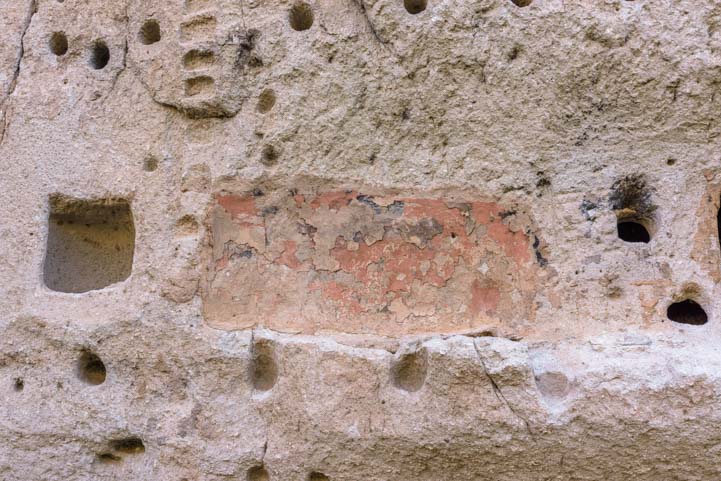
The “fresco” walls are peeling but are clearly visible.
Some of the indents in the cliffs were deeper than others, and many seemed to have been decorated with a kind of wainscotting. The plaster on the lower half of those walls had been painted, while the upper half of the walls and roof were black from soot and smoke from their household fires.

Some walls had a kind of wainscotting with the lower half decorated in colored “plaster” and the upper half black from soot. A bullseye petroglyph adorns the wall of top floor.

A closer look at the “wainscotting.”
One of the indents was decorated with an artistic gemoetric pattern. The National Park Service has black and white photos of this wall from years ago where a ranger was pointing it out to visitors, right up close.
Now visitors have to stand far back from the cliff wall and the decocrative pattern is covered with a protective covering so it doesn’t vanish too quickly in the elements.

One wall with a particularly vivid pattern is protected from the elements.
The Long House goes on for a very long distance with room after room lined up along the cliff face. It seems that the adobe brick structures that fronted these back walls extended out about two room’s width from the cliff wall, and the buildings were generally two or three stories tall too.

The Long House is very long and the trail wanders alongside it.

Some holes, or caves, are natural but others are rectangular and very obviously man-made.
We saw only two petroglyphs, but there are probably more. A bull’s-eye was pecked out of the cliffs in an upper story in one area, and an unrecognizable animal was pecked out high up in another.

Some strange animal…
Eventually, leaving the Long House behind, the Main Loop trail took us through a ponderosa pine tree studded woodsy area. Pretty wildflowers looked up at us.

.
Then we arrived at Alcove House, a massive natural cave that lies high up on the cliffs. The ancients must have used ladders to get up to this cave, and the National Park Service has placed ladders leading up to it for us modern visitors to use.
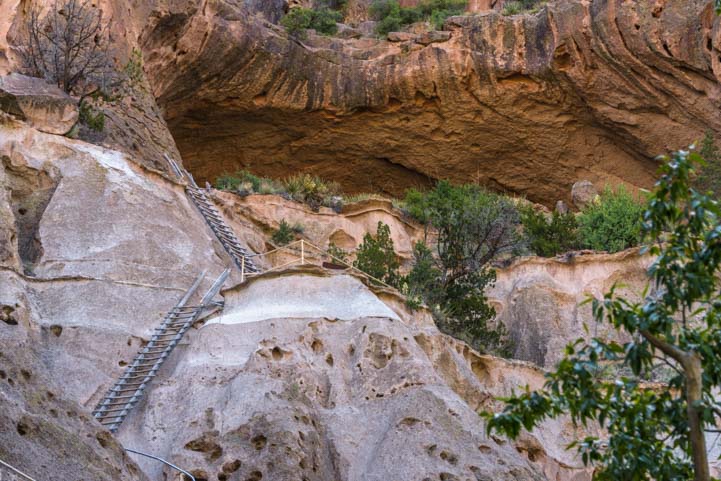
Alcove House is reached by two very long ladders and a third shorter ladder.

.
What a climb!

.

.
The Alcove House cave is huge and may have housed all kinds of rooms and other things. There are remnants of a circular kiva which has been restored but can’t be entered.

The cave at Alcove House is very deep and must have offered great natural protection.
We liked the two person-sized openings that went into very small closet-like rooms!

.
After getting our fill of these ruins (for one day), we returned to the visitors center where we saw a very cool RV parked in the parking lot. It had animal tracks painted on one side and Chinese letters on the other and sported a German flag by the door.
Ironically, as I write this post a month later, we saw the exact same rig parked in Custer, South Dakota, earlier today. It is a small world!

Back at the Visitors Center we saw this unusual rig…and then saw it again a month later 700 miles away!
Another day we ventured out to Bandelier National Monument’s waterfall which lies at the end of the mile-and-a-half long Falls Trail.
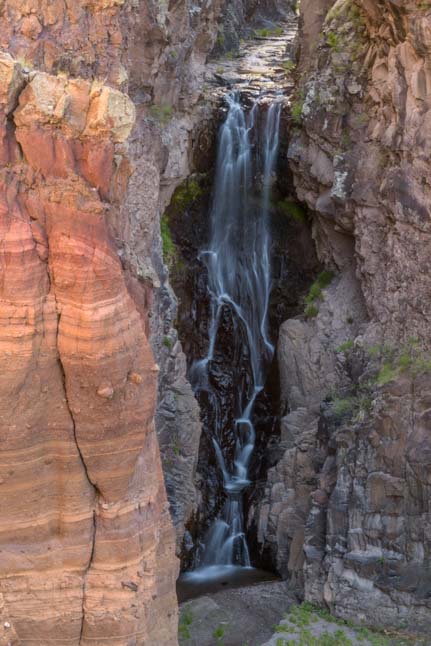
A beautiful waterfall is the reward at the end of the Falls Trail.
There are ancient ruins all over America’s southwest, and various groups of modern day Native Americans believe they are descended from certain ancient cultures in different locations.
Interestingly, the modern Pueblo Indians who claim descent from the ancient people who built the Long House and Alcove House at Bandelier National Monument are the Cochiti Puebloans who live a ways away near Cochiti Lake and Tent Rocks.
The modern Pueblo Indians who live closest to Bandelier National Monument, the San Ildefonso Puebloan people, claim descent from the unexcavated ruins that lie just outside Bandelier at Tsankawai Ruins.
The hike through Tsankawai Ruins began with a ladder climb as well, but it was totally different in nature because the ruins don’t back up to a massive cliff face and they are hard to spot on the grassy plateau since they haven’t been dug up yet.

A ladder at the beginning of the Tsankawai Ruins Trail.
Unlike all ancient archaeological sites where the ruins have been studied, thoroughly excavated, stabilized and rebuilt, the Tsankawai Ruins site is an explorer’s dream because some artifacts are still lying around.
I was shocked when Mark pointed to a rock that had some pottery shards lying on it. It didn’t take long for us to find a few others in the grass and dirt nearby.
Obviously, we left them in place so the next visitors could enjoy the same surprise as we did, but how fabulous it was to see the finely painted decorations on these centuries old bits of pottery.

Painted pottery shards on the Tsankawai Ruins Trail.
The Tsankawai Loop trail can be done either clockwise or counterclockwise, and we chose to go in the clockwise direction (taking a left at “Loop Trail” sign). After crossing a high plateau where the ancient ruins lie sunken into the dirt, the trail seemed to end. After a little scouting over the edge Mark noticed a ladder going down, so down we went.
I wonder how many people simply turn around at that point not knowing the trail continues down the well obscured ladder! Going in the counter clockwise direction, this ladder would be very obvious as the trail leads right to its base.

.
We skirted along the edge of a sloping hillside with wonderful views to one side, and rounded a bend to find some petroglyphs on a rock wall next to us.
Except for a spiral, the imagery was nothing like other petroglyphs we have seen elsewhere.
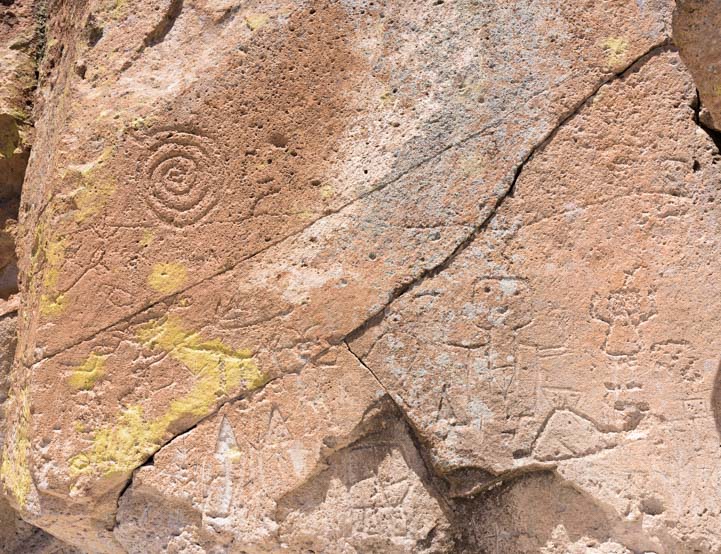
.
We continued on and were absolutely floored by the many very narrow foot trails that have been carved into the rock.

The Tsankawai Ruins Trail includes some very cool skinny and curvy paths.
These were very clearly man-made and not the work of water or wind. But they weren’t made by the National Park Service either!

.
In another spot, we looked up along the rounded rock hills and noticed a little staircase that had been carved out of the rock.
How ingenious of the ancients to make these trails and staircases, and what a wonderful way for us to be transported back to a time centuries ago.

In the footprints of the ancients…
If you are traveling in New Mexico with your RV — or if you find yourself anywhere near this area without an RV! — Bandelier National Monument is a true jewel that is well worth visiting.
For the Main Loop Trail to the Long House and Alcove House, be sure to get there early on a weekday if you want to see the ruins without the crowds. The Falls Trail and Tsankawai Ruins are much less visited.
More links and info below…
Subscribe
Never miss a post — it’s free!
More info about Bandelier National Monument and Tsankawai Ruins:
- Bandelier National Monument – Official National Park Service Website
- Shuttle Bus Info (Atomic City Transit) – Official NPS Website
- Main Loop Trail – NPS Website
- Falls Trail – NPS Website
- Tsankawai Ruins Trail – NPS Website
- Campgrounds and RV Parks near Bandelier National Monument – RV Park Reviews
- Locations of Bandelier National Monument and Tsankawai Ruins – Interactive Google Maps
Other ancient ruins in America’s southwest:
- Windy Hill Campground + Tonto National Monument
- Aztec Ruins National Monument – Whispers from the Ancients in New Mexico!
- Tonto National Monument AZ – Workamping with the Ancients!
- Tonto National Monument AZ – Lower Cliff Dwellings
- Montezuma’s Castle & Schnebly Hill – Sedona Heights!
- Mesa Verde National Park, CO – Life on the Edge with the Ancients
- Wupatki Nat’l Monument – Ancient Indian Ruins & Great Camping in AZ!
Blog posts from our RV travels in New Mexico
Our most recent posts:
- Beehive Trail in Arizona – A “Mini Wave” hike by Lake Powell 07/19/24
- Reese Goose Box Review: 20K Gen 3 TESTED + How to Hitch 06/27/24
- Lake Powell – Heart of Glen Canyon National Recreation Area 05/10/24
- Quick Release Pull Pins for Fifth Wheel Landing Jacks – YES! 05/03/24
- Sheep May Safely Graze (in the Mountains with Dogs!) 04/26/24
More of our Latest Posts are in the MENU.
New to this site? Visit RVers Start Here to find where we keep all the good stuff!!
<-Previous || Next->

..an all-time favorite site, report and photos ! Love those caves, ladders, narrow paths – and toe-hold climbs ! Thanks for the “feel” for life – in another time and place 🙂
These are very fun ruins. Even though some locals are nostalgic for the good old days when there was more freedom to play in and around the ruins, the NPS has done a good job of implementing “crowd control” tactics without losing too much “playfulness,” and they are a blast to explore.
Wow! That’s a lot of stairs to climb. Somebody made a lot of ladders? Looks like you had a great time. Thanks for sharing. I’m guessing you’ll head to cooler areas as summer hits the deserts?
Hey Rose, great to hear from you! We were in a blizzard just a few days after this post, and we’ve had cool weather ever since. Somehow we managed to escape the huge heat wave just in the nick of time. We’re still running our heater some mornings!
That is a really cool adventure! I never heard of this place but would like to visit someday! 🙂
We’d never heard of it either, but what a wonderful gem it is!!
The hubby and I are recently retired and plan on traveling full-time. I came across your blog and was so excited! I thoroughly enjoyed this post and am looking forward to visiting New Mexico. It has simply been a drive through state; but, now we can’t wait to take our time there!
New Mexico has a lot of hidden gems, Gwen, and we’re not done finding them all — by a long stretch! Congrats on deciding to travel full-time. I’m so glad you found our blog, and I hope it gives you lots of inspiration and perhaps a tip or two as you prepare for your upcoming adventures. Have fun exploring New Mexico and all the other beautiful states in America. There is so much to see and enjoy!